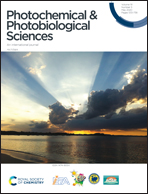Laser-induced fluorescence spectroscopy for early disease detection in grapefruit plants†
Abstract
Biotic and abiotic stress both cause a considerable decrease in the chlorophyll content in plant leaves, which provides a means for the early diagnosis of diseases in plants. The emergence of diseases affects the fluorescence of phenolic compounds and chlorophyll, which have emissions located at 530, 686 and 735 nm. Herein, it was found that the intensity of the emission band of phenolic compounds at 530 nm increased and that of chlorophyll at 735 nm decreased with the onset of diseases. Statistical analysis through principal component analysis (PCA) and partial least squares regression (PLSR) was performed, which differentiated between apparently healthy leaf sites and diseased leaves, providing a basis for the detection of diseases in the early stages. The PLSR model was validated through the coefficient of determination (R2), standard error of prediction (SEP) and standard error of calibration (SEC) with the values of 0.99, 0.394 and 0.0.401, respectively, which authenticated the model. The prediction accuracy of the model was evaluated through root mean square error in prediction (RMSEP), with a value of 0.14, by predicting 22 unknown emission spectra of different leaf sites. Both the PCA and PLSR models produced similar results, proving that fluorescence spectroscopy is an excellent tool for early disease detection in plants.



 Please wait while we load your content...
Please wait while we load your content...